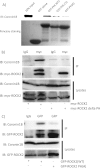Novel mechanism for negatively regulating Rho-kinase (ROCK) signaling through Coronin1B protein in neuregulin 1 (NRG-1)-induced tumor cell motility
- PMID: 22563075
- PMCID: PMC3381146
- DOI: 10.1074/jbc.M112.346114
Novel mechanism for negatively regulating Rho-kinase (ROCK) signaling through Coronin1B protein in neuregulin 1 (NRG-1)-induced tumor cell motility
Abstract
Although many mechanisms that activate ROCK are known, corresponding negative regulatory mechanisms required for cytoskeletal plasticity are poorly understood. We have discovered that Coronin1B is a novel attenuator of ROCK signaling. We initially identified Coronin1A in a proteomics screen for ROCK2-binding proteins, and here we demonstrate that Coronin1A/B bind directly to ROCK2 through its PH (Pleckstrin Homology) domain. The consequence of the ROCK2-Coronin1B interaction was tested and revealed that increased expression of Coronin1B inhibited, whereas knockdown of Coronin1B stimulated, phosphorylation of the ROCK substrate myosin light chain phosphatase and subsequently, myosin light chain. Thus, Coronin1B is a previously unrecognized inhibitor of ROCK signaling to myosin. Furthermore, we found that the phosphatase Slingshot IL (SSH1L) was required for Coronin1B to inhibit ROCK signaling. To test the significance of this novel mechanism in tumor cell motility, we investigated its role in neuregulin 1 (NRG-1)-induced cell scattering. Importantly, we found that attenuation of the ROCK signaling by Coronin1B was required for NRG-1 stimulated scattering. Our data support a model in which Coronin1B fine-tunes ROCK signaling to modulate myosin activity, which is important for tumor cell motility.
Figures







Similar articles
-
Rho-associated kinase and zipper-interacting protein kinase, but not myosin light chain kinase, are involved in the regulation of myosin phosphorylation in serum-stimulated human arterial smooth muscle cells.PLoS One. 2019 Dec 13;14(12):e0226406. doi: 10.1371/journal.pone.0226406. eCollection 2019. PLoS One. 2019. PMID: 31834925 Free PMC article.
-
p90 ribosomal S6 kinase (RSK) phosphorylates myosin phosphatase and thereby controls edge dynamics during cell migration.J Biol Chem. 2019 Jul 12;294(28):10846-10862. doi: 10.1074/jbc.RA119.007431. Epub 2019 May 28. J Biol Chem. 2019. PMID: 31138649 Free PMC article.
-
Deleted in liver cancer 1 (DLC1) negatively regulates Rho/ROCK/MLC pathway in hepatocellular carcinoma.PLoS One. 2008 Jul 23;3(7):e2779. doi: 10.1371/journal.pone.0002779. PLoS One. 2008. PMID: 18648664 Free PMC article.
-
Rho-associated coiled-coil kinase (ROCK) signaling and disease.Crit Rev Biochem Mol Biol. 2013 Jul-Aug;48(4):301-16. doi: 10.3109/10409238.2013.786671. Epub 2013 Apr 19. Crit Rev Biochem Mol Biol. 2013. PMID: 23601011 Review.
-
Rho signaling, ROCK and mDia1, in transformation, metastasis and invasion.Cancer Metastasis Rev. 2009 Jun;28(1-2):65-76. doi: 10.1007/s10555-008-9170-7. Cancer Metastasis Rev. 2009. PMID: 19160018 Review.
Cited by
-
Coronin1 proteins dictate rac1 intracellular dynamics and cytoskeletal output.Mol Cell Biol. 2014 Sep 15;34(18):3388-406. doi: 10.1128/MCB.00347-14. Epub 2014 Jun 30. Mol Cell Biol. 2014. PMID: 24980436 Free PMC article.
-
Neuregulin‑1 protects cardiac function in septic rats through multiple targets based on endothelial cells.Int J Mol Med. 2019 Oct;44(4):1255-1266. doi: 10.3892/ijmm.2019.4309. Epub 2019 Aug 8. Int J Mol Med. 2019. PMID: 31432099 Free PMC article.
-
Novel Insights into the Roles of Rho Kinase in Cancer.Arch Immunol Ther Exp (Warsz). 2016 Aug;64(4):259-78. doi: 10.1007/s00005-015-0382-6. Epub 2016 Jan 2. Arch Immunol Ther Exp (Warsz). 2016. PMID: 26725045 Free PMC article. Review.
-
Discovery of vascular Rho kinase (ROCK) inhibitory peptides.Exp Biol Med (Maywood). 2019 Aug;244(11):940-951. doi: 10.1177/1535370219849581. Epub 2019 May 27. Exp Biol Med (Maywood). 2019. PMID: 31132884 Free PMC article.
-
Rho-associated coiled-coil containing kinases (ROCK): structure, regulation, and functions.Small GTPases. 2014;5:e29846. doi: 10.4161/sgtp.29846. Epub 2014 Jul 10. Small GTPases. 2014. PMID: 25010901 Free PMC article. Review.
References
-
- Fischer O. M., Hart S., Gschwind A., Ullrich A. (2003) EGFR signal transactivation in cancer cells. Biochem. Soc. Trans. 31, 1203–1208 - PubMed
-
- Gray S. G., Stenfeldt Mathiasen I., De Meyts P. (2003) The insulin-like growth factors and insulin-signaling systems: an appealing target for breast cancer therapy? Horm. Metab. Res. 35, 857–871 - PubMed
-
- Yarden Y., Sliwkowski M. X. (2001) Untangling the ErbB signalling network. Nat. Rev. Mol. Cell. Biol. 2, 127–137 - PubMed
Publication types
MeSH terms
Substances
Grants and funding
LinkOut - more resources
Full Text Sources
Other Literature Sources

